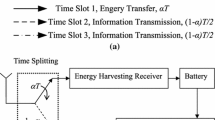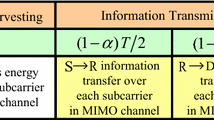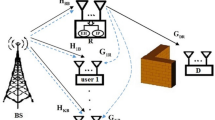Abstract
In this paper, we consider simultaneous wireless information and energy transfer in an orthogonal-frequency-division-multiple-access decode-and-forward relay network, in which an energy-constrained relay node harvests energy from a source node and uses the harvested energy to forward information to multiple destination nodes. Our objective is to maximize the end-to-end sum rate by resource allocation, subject to transmit power constraint at the source and energy-harvesting (EH) constraint at the relay. A non-convex and mixed-integer programming (MIP) problem is formulated to optimize time-switching (TS) ratios of EH and information decoding at the relay, TS ratio of information transmission from relay to destinations, subcarrier allocation as well as power allocation (PA) over all subcarriers at source and relay. We propose to decouple this problem into a convex problem and an MIP problem in fractional form. To solve the MIP problem, we transform it into an equivalent optimization problem in subtractive form which has a tractable solution. As a result, we propose a novel scheme to achieve jointly optimal TS ratios, subcarrier allocation and PA. Simulation results verify the optimality of our proposed resource allocation scheme.









Similar content being viewed by others
References
Yang, X. X., Jiang, C., Elsherbeni, A. Z., Yang, F., & Wang, Y. Q. (2013). A novel compact printed rectenna for data communication systems. IEEE Transactions on Antennas Propagation, 61, 2532–2539.
Monti, G., Corchia, L., & Tarricone, L. (2013). UHF wearable rectenna on textile materials. IEEE Transactions on Antennas Propagation, 61, 3869–3873.
Varshney, L. R. (2008). Transporting information and energy simultaneously. In IEEE international symposium on information theory (ISIT) (pp.1612–1616).
Zhou, X., Zhang, R., & Ho, C. K. (2013). Wireless information and power transfer: Architecture design and rate-energy tradeoff. IEEE Transactions on Communications, 61(11), 4754–4767.
Zhang, R., & Ho, C. K. (2013). MIMO broadcasting for simultaneous wireless information and power transfer. IEEE Transactions on Wireless Communications, 12(5), 1989–2001.
Zhou, X., Zhang, R., & Ho, C. K. (2013). Wireless information and power transfer: Architecture design and rate-energy tradeoff. IEEE Transactions on Wireless Communications, 61(11), 4754–4767.
Liu, L., Zhang, R., & Chua, K. C. (2013). Wireless information transfer with opportunistic EH. IEEE Transactions on Wireless Communications, 12(1), 4440–4453.
Huang, K., & Larsson, E. (2013). Simultaneous information and power transfer for broadband wireless systems. IEEE Transactions on Signal Processing, 61(23), 5972–5986.
Nasir, A. A., Zhou, X., Durrani, S., & Kennedy, R. A. (2013). Relaying protocols for wireless energy harvesting and information processing. IEEE Transactions on Wireless Communications, 12(7), 3622–3636.
Nasir, A. A., Zhou, X., Durrani, S., & Kennedy, R. A. (2013). Wireless-powered relays in cooperative communications: Time-switching relaying protocols and throughput analysis. IEEE Transactions on Communications, 63(5), 1607–1622.
Ding, Z., & Poor, H. V. (2013). Cooperative energy harvesting networks with spatially random users. IEEE Signal Processing Letters, 20(12), 1211–1214.
Ding, Z., Krikidis, I., Sharif, B., & Poor, H. V. (2014). Wireless information and power transfer in cooperative networks with spatially random relays. IEEE Transactions on Wireless Communications, 13(8), 4440–4453.
Panagiotis, D., Georgia, D., Koralia, N., George, K., & Bayan, S. (2015). Throughput maximization in multicarrier wireless powered relaying networks. IEEE Wireless Communication Letters, 4(4), 385–388.
Xiong, K., Fan, P., Zhang, C., & Letaief, K. B. (2015). Wireless information and energy transfer for two-hop non-regenerative MIMO-OFDM relay networks. IEEE Journal on Selected Areas in Communications, 33(8), 1595–1611.
Huang, G. F., Zhang, Q., & Qin, J. Y. (2015). Joint time switching and power allocation for multicarrier decode-and-forward relay networks with SWIPT. IEEE Signal Processing Letters, 22(12), 2284–2288.
Krikidis, I., Timotheou, S., & Sasaki, S. (2012). RF energy transfer for cooperative networks: Data relaying or energy harvesting? IEEE Communication Letters, 16(11), 1772–1775.
Zhou, N., Zhu, X., Gao, J., & Huang, Y. (2010). Optimal asymmetric resource allocation with limited feedback for OFDM based relay systems. IEEE Transactions on Wireless Communications, 9(2), 4440–4453.
Zhou, N., Zhu, X., & Huang, Y. (2011). Optimal asymmetric resource allocation and analysis for OFDM-based multidestination relay systems in the downlink. IEEE Transactions on Vehicular Technology, 60(3), 1307–1312.
Hajiaghayi, M., Dong, M., & Liang, B. (2012). Jointly optimal channel and power assignment for dual-hop multi-channel multi-user relaying. IEEE Journal on Selected Areas in Communications, 30(9), 1806–1814.
Hajiaghayi, M., Dong, M., & Liang, B. (2011). Optimal channel assignment and power allocation for dual-hop multi-channel multi-user relaying. In IEEE international conference on computer communications (INFORCOM) (pp. 76–80).
Goldsmith, A. (2005). Wireless communications. Cambridge: Cambridge University Press.
Boyd, S., & Vandenberghe, L. (2004). Convex optimization. Cambridge: Cambridge University Press.
Channappayya, S. S., Bovik, A. C., Caramanis, C., & Heath, R. W. (2008). Design of linear equalizers optimized for the structural similarity index. IEEE Transactions on Image Processing, 17(6), 857–872.
Corless, R. M., Gonnet, G. H., Hare, D. E. G., Jeffrey, D. J., & Knuth, D. E. (1996). On the Lambert W function. Advances in Computational Mathematics, 5(1), 329–359.
Acknowledgments
This work was supported in part by the National Natural Science Foundation of China under Grant 61472458, Grant 61202498, and Grant 61173148, in part by Guangdong Natural Science Foundation under Grant 2014A030310349, in part by Guangdong Science & Technology Project under Grant 2013B010402018 and Grant 2012A010800009, in part by Guangzhou Science & Technology Fund under Grant 2014J4100142, Grant 2014J4100233 and Grant 2014A030310349, in part by Guangzhou Education Bureau Science & Technology Project under Grant 2012A082 and in part by Guangzhou Colleges and Universities Project under Grant 1201421329.
Author information
Authors and Affiliations
Corresponding author
Appendices
Appendix 1
Proof of Proposition 2
By introducing a slack variable \(\theta \), we firstly rewrite problem (20) equivalently as
This holds since minimizing \(\theta \) is the same as finding the least upper bound of the objective function of problem (20), which is equal to the maximum value of objective function [23]. The problem (36) is further recast as [23]
where \(F\left( \mathbf {P}^{\mathrm{R}},\Phi ,\theta \right) \) is defined in (22). This holds since \(\sum _{k=1}^K\sum _{n=1}^{N}P^{\mathrm{R}}_{k,n}+G\) is strictly positive. Then, \(\theta \) is a true upper bound if the problem
has a non-negative optimal value. Specially, if and only if \(\theta =\overline{\theta }\), where \(\overline{\theta }\) is the solution of the equation \(T(\overline{\theta })=0\), in which \(T(\theta )\) is defined in (23), the optimal value of problem (20) is \(\overline{\theta }\), and \(\left( \overline{\mathbf {P}}^{\mathrm{R}}, \overline{\Phi }\right) = \arg \max _{\mathbf {P}^{\mathrm{R}},\Phi } F\left( \mathbf {P}^{\mathrm{R}},\Phi ,\overline{\theta }\right) \) is the optimal solution to problem (20). The proof is completed. □
Appendix 2
Proof of Proposition 3
Introduce a variable
Then \(\varphi \sum _{k=1}^{K} \sum _{n=1}^{N}P_{k,n}^{\mathrm{R}}=(1-\varphi ) G\). Since \(0\le \varphi \le 1\), it follows
In addition, according to (38), the objective function of problem (20) can be rewritten as
It is obvious that allowing all destinations to receive data information over all subcarriers, which results in \(\phi _{k,n}^{\mathrm{RD}}=1\) for all \(k\in K\) and \(n \in N\), will increase the end-to-end achievable sum rate. Then we have
with \(S=G \max _{k,n}\left\{ \gamma ^{\mathrm{RD}}_{k,n}\right\} \). Since \(1+S+S/\varphi \le \left( 1+S\right) \left( 1+1/\varphi \right) \) and \(\varphi \le 1\), we have
It can be verified that \(f(\varphi )=\varphi \log \left( 1+1/\varphi \right) \) is concave. The maximum value of \(f(\varphi )\) is obtained by letting \(df(\varphi )/d\varphi =0\). Thus, we have \(\exp (1/(1+\varphi ))=(1+\varphi )/\varphi \). Using the Lambert \({\mathcal {W}}\) Function [24], the solution to the problem \(\max _{\varphi }f(\varphi )\) is \(\varphi =\vartheta ={\mathcal {W}}\left( -\frac{1}{e}\right) \).□
Rights and permissions
About this article
Cite this article
Huang, G., Tang, D., Zhao, S. et al. Optimal simultaneous wireless information and energy transfer in OFDMA decode-and-forward relay networks. Wireless Netw 23, 1731–1742 (2017). https://doi.org/10.1007/s11276-016-1249-4
Published:
Issue Date:
DOI: https://doi.org/10.1007/s11276-016-1249-4




